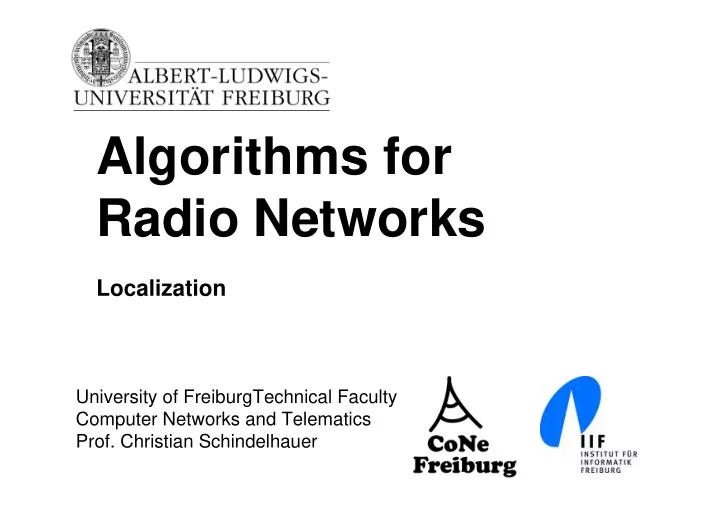

Algorithms for Radio Networks Localization University of FreiburgTechnical Faculty Computer Networks and Telematics Prof. Christian Schindelhauer
Trilateration ‣ Assuming the distance to three points is given ‣ System of equations • (x i , y i ): coordinates of an anchor point i, • r distance from the anchor point i • (x u , y u ): unknown coordinates of a node ‣ Problem: Quadratic equations • Transformations lead to a linear system of equations Algorithms for Radio Networks Computer Networks and Telematics 28 Prof. Christian Schindelhauer University of Freiburg
Trilateration ‣ System of equations ‣ Transformation • results in: Algorithms for Radio Networks Computer Networks and Telematics 29 Prof. Christian Schindelhauer University of Freiburg
Trilateration as a Linear System of Equations ‣ Forming a system of equations ‣ Example: • (x 1 , y 1 ) = (2,1), (x 2 , y 2 ) = (5,4), (x 3 , y 3 ) = (8,2), • r 1 = 10 1/2 , r 2 = 2, r 3 = 3 � (x u ,y u ) = (5,2) Algorithms for Radio Networks Computer Networks and Telematics 30 Prof. Christian Schindelhauer University of Freiburg
Trilateration as a Linear System of Equations ‣ In three dimensions • Intersection of four spheres ‣ Solve Ax = b � x = A -1 b Algorithms for Radio Networks Computer Networks and Telematics 31 Prof. Christian Schindelhauer University of Freiburg
Trilateration ‣ In case of measurement errors [F. Höflinger, 2013] ‣ Averaging: e.g. centroid of triangle Algorithms for Radio Networks Computer Networks and Telematics 32 Prof. Christian Schindelhauer University of Freiburg
Trilateration ‣ Measurement errors • Small distance errors can lead to large position errors or ‣ flip ambiguity from noise Algorithms for Radio Networks Computer Networks and Telematics 33 Prof. Christian Schindelhauer University of Freiburg
Multilateration with absolute distances ‣ Multilateration (absolute distances): Calculate the intersection of at least four distance measurements • May be over-determined equation system: More equations than variables • “No solution” in case of measurement errors ‣ Minimize sum of quadratic residuals: Least squares ‣ Vector notation • Solve (A T A)x = A T b � x = (A T A) -1 A T b • Matrix inverse by Gauss-Jordan elimination Algorithms for Radio Networks Computer Networks and Telematics 34 Prof. Christian Schindelhauer University of Freiburg
Multilateration with relative distances ‣ Multilateration (relative): Calculate the intersection of relative distance measurements • Emission time e unknown! • Measure only reception times T i , i = 1 , ..., n • System of equations T i = e + || r i – s || / c • ...for a signal traveling from s to receivers r i ‣ Subtract two absolute times T i and T j : • T i – T j = || r i – s || / c – || r j – s || / c =: Δ t ( i , j = 1, ..., n ) • System of hyperbolic equations • Time Difference of Arrival Δ t , relative distance Δ d = c Δ t Algorithms for Radio Networks Computer Networks and Telematics 35 Prof. Christian Schindelhauer University of Freiburg
Multilateration with relative distances ‣ Advantages • No cooperation of signal emitter • Hardware delays cancel out (both emitter and receiver) • Passive localization / natural signal sources ‣ Disadvantages • Larger number of unknown values: Position and time • Synchronization still (usually) required Algorithms for Radio Networks Computer Networks and Telematics 36 Prof. Christian Schindelhauer University of Freiburg
Anchor-free localization ‣ “Anchor-free localization”: • Hyperbolic multilateration • Unknown emitters s j , and unknown receivers r i ‣ Advantages: • No need to measure receiver positions • Self-positioning by passive information from the surroundings ‣ Disadvantages: • Even larger number of unknown variables Algorithms for Radio Networks Computer Networks and Telematics 37 Prof. Christian Schindelhauer University of Freiburg
Anchor-free localization ‣ For absolute distances d ik : • Solve || r i – s k || = d ik ( i, j = 1, ..., n ; k = 1, ..., m ) • Problem of intersecting circles / spheres • Bipartite distance graph: G = ( { r i }, { s k }, { d ( i , k )} ) • Minimum case closed-from solutions known [Kuang, et al., ICASSP 2013] Algorithms for Radio Networks Computer Networks and Telematics 38 Prof. Christian Schindelhauer University of Freiburg
Anchor-free localization ‣ For relative distances Δ d ijk = d ik – d jk : • Solve || r i – s k || – || r j – s k || = Δ d ijk • Problem of intersecting hyperbolas / hyperboloids • Closed-form solutions only for larger problem sets [Pollefeys and Nister, ICASSP 2008], [Kuang and Åström, EUSIPCO 2013] • Minimum problem set: Iterative/recursive approximations [Wendeberg and Schindelhauer, Algosensors 2012] Algorithms for Radio Networks Computer Networks and Telematics 39 Prof. Christian Schindelhauer University of Freiburg
Anchor-free localization T ik = e ik + || r i – s k || / c ‣ Degrees of freedom ( e ik , r i , s k unknown) G 2D = 2 n + 3 m – nm – 3 G 3D = 3 n + 4 m – nm – 6 Algorithms for Radio Networks Computer Networks and Telematics 40 Prof. Christian Schindelhauer University of Freiburg
Anchor-free localization ‣ Minimum cases 2D 3D general setting 4 / 6 5 / 10 6 / 7 far-field setting 3 / 3 (sync.) 4 / 6 (sync.) 3 / 5 (unsync.) 4 / 9 (unsync.) Minimum number of required receivers / emitters Algorithms for Radio Networks Computer Networks and Telematics 41 Prof. Christian Schindelhauer University of Freiburg
Algorithms for Radio Networks Localization University of FreiburgTechnical Faculty Computer Networks and Telematics Prof. Christian Schindelhauer
Recommend
More recommend